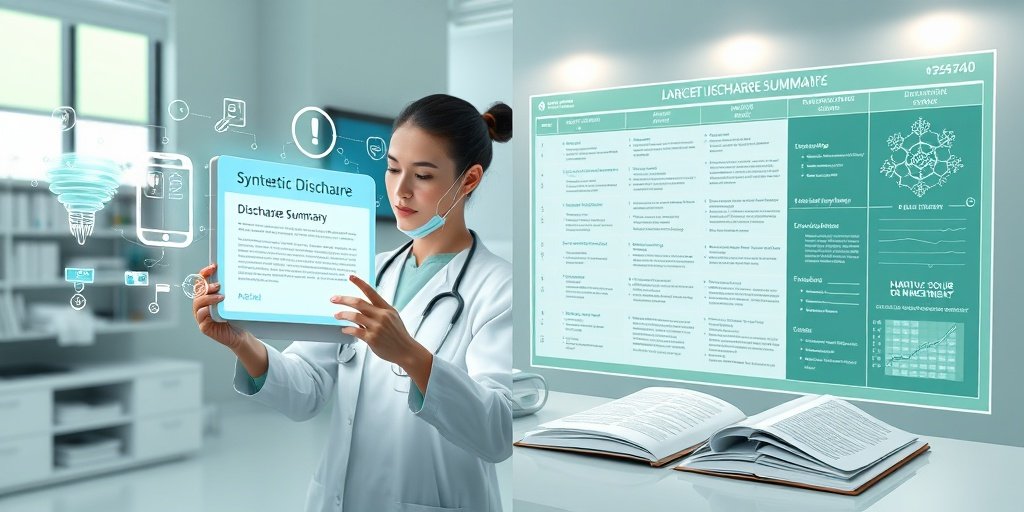⚡ Quick Summary
The study introduces SynthMedic, a novel methodology utilizing large language models (LLMs) to generate, validate, and correct synthetic discharge summaries without real patient data. The generated summaries achieved a remarkable System Usability Score of 94.35% and a Faithfulness metric score of 93.65%, demonstrating their credibility and accuracy.
🔍 Key Details
- 📊 Dataset: 900 synthetic discharge summaries
- 🧩 Diseases covered: Nine socially significant diseases
- ⚙️ Technology: Large Language Models (LLMs) and Knowledge Graphs
- 🏆 Performance: System Usability Score: 94.35%, Faithfulness Score: 93.65%
🔑 Key Takeaways
- 💡 Synthetic clinical texts can enhance transparency and reduce bias in medical training.
- 🤖 LLMs were employed to generate discharge summaries grounded in established medical practices.
- 👩⚕️ Human expert validation confirmed the credibility and factual accuracy of the generated summaries.
- 📚 Open access to the synthetic corpus allows for broader use in training machine learning models.
- 🌍 The methodology can assist medical professionals in their daily work without compromising patient privacy.
- 🔄 Automatic correction of summaries ensures ongoing medical factual correctness.
- 📈 Potential for future research in synthetic text generation for various medical applications.

📚 Background
The generation of synthetic clinical texts is a promising avenue for improving the training and evaluation of specialized language models in the medical domain. By utilizing synthetic data, researchers can enhance transparency and reduce costs while ensuring that no real patient information is compromised. This study aims to develop a robust methodology for generating discharge summaries that can be tailored for specific medical tasks.
🗒️ Study
The research focused on creating a methodology for generating synthetic discharge summaries using LLMs, grounded in standard medical references such as the Merck Manuals. The study involved validating the generated summaries through both LLMs and human expert evaluations, ensuring that the outputs were not only credible but also aligned with internationally accepted medical practices.
📈 Results
The results from the human expert evaluation indicated that the synthetic discharge summaries were both credible and factually accurate when contextualized with medical references. The summaries achieved a System Usability Score of 94.35% and a Faithfulness metric score of 93.65%, showcasing their high quality and reliability for practical use.
🌍 Impact and Implications
The implications of this study are significant for the medical community. By providing a methodology for generating high-quality synthetic discharge summaries, healthcare professionals can leverage these tools to enhance their workflows without the ethical concerns associated with using real patient data. This innovation could lead to improved training for machine learning models, ultimately benefiting patient care and medical research.
🔮 Conclusion
The SynthMedic study highlights the transformative potential of large language models in generating synthetic clinical texts. By ensuring high usability and factual accuracy, this methodology paves the way for future advancements in medical documentation and training. The open-access nature of the generated corpus invites further exploration and application in the healthcare sector, promising a brighter future for AI integration in medicine.
💬 Your comments
What are your thoughts on the use of synthetic discharge summaries in healthcare? We would love to hear your insights! 💬 Join the conversation in the comments below or connect with us on social media:
SynthMedic: Utilizing large language models for synthetic discharge summary generation, correction and validation.
Abstract
BACKGROUND AND OBJECTIVE: Synthetic clinical texts can improve transparency and reduce bias and costs when training and evaluating specialized language models in the medical domain. Synthetic texts are freely shareable, as they contain no real patient information, and can be customized for a specific task. The objective of this study is to develop a methodology for generating, validating, and correcting synthetic discharge summaries using LLMs without requiring any real patient data.
METHODS: The proposed approach uses an LLM to generate synthetic discharge summaries for specific diseases and standard medical references from Merck Manuals to ground the generation in internationally accepted medical practices. We validate the generated summaries using LLMs as well as by human expert validation. In addition, we propose a method for automatic correction of the generated discharge summaries using Knowledge Graphs to ensure medical factual correctness.
RESULTS: The conducted human expert evaluation shows that the generated synthetic discharge summaries are credible and factually accurate when provided with the medical reference context. The generated summaries achieve a System Usability Score of 94.35% based on a comprehensive rubric evaluated by medical professionals and a score of 93.65% on the Faithfulness metric evaluated by an LLM.
CONCLUSIONS: The proposed methodology can be utilized to generate high-quality synthetic discharge summaries for various diseases. The generated synthetic corpus consists of 900 discharge summaries in English representing nine socially significant diseases and is publicly available under an open license. The community can take advantage of the corpus and proposed methodology to train complex machine learning models, helping medical professionals in their daily work without using real patient data.
Author: [‘Grazhdanski G’, ‘Vasilev V’, ‘Vassileva S’, ‘Taskov D’, ‘Antova I’, ‘Koychev I’, ‘Boytcheva S’]
Journal: J Biomed Inform
Citation: Grazhdanski G, et al. SynthMedic: Utilizing large language models for synthetic discharge summary generation, correction and validation. SynthMedic: Utilizing large language models for synthetic discharge summary generation, correction and validation. 2025; (unknown volume):104906. doi: 10.1016/j.jbi.2025.104906